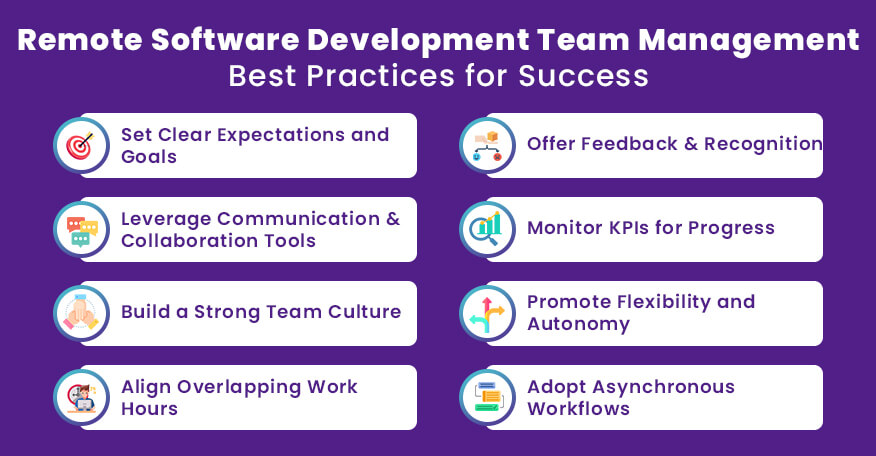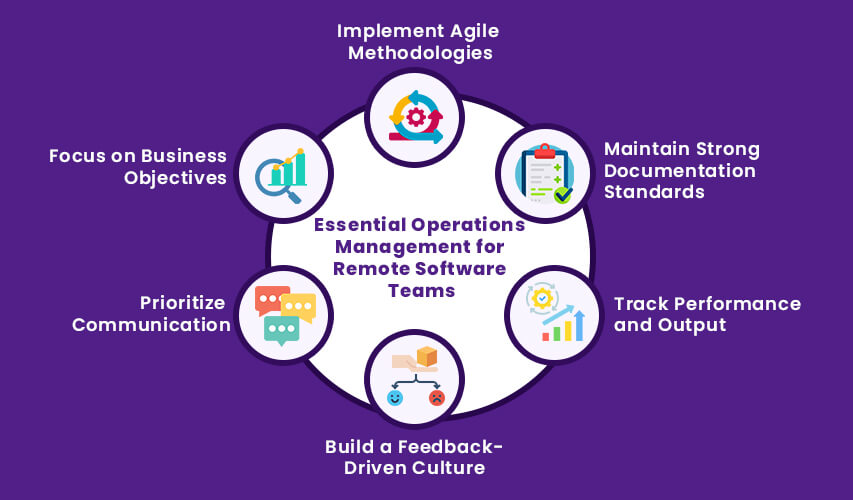
Running a remote software development team comes with its unique challenges. When your team members are scattered across the globe, day-to-day management can feel overwhelming. Traditional in-house teams once dominated the industry, but today, companies seek agility, scalability, and cost-efficiency more than ever.
That’s where partnering with software development companies that specialize in remote teams makes a real difference. Outsourcing unlocks access to world-class talent, speeds up project delivery, and significantly cuts costs. It’s a smart move for businesses wanting to stay competitive.
Still, remote team management isn’t always easy. As a leader, you might struggle to monitor daily activities, foster clear communication, and keep everyone aligned with business goals. Time zone gaps, cultural differences, and diverse work ethics can create friction and slow progress.
But here’s the good news with the right approach, you can overcome these hurdles. A well-managed remote development team can produce outstanding results, driving innovation and growth for your business.
In this guide, we’ll share proven strategies and best practices for managing remote teams effectively. Whether you’re outsourcing for the first time or optimizing your existing setup, these insights will help you navigate the complexities of remote software development management.
Table of Contents
- What’s the Real Challenge in Managing a Remote Software Development Team?
- How to Manage a Software Development Team Working Remotely?
- Set Clear Expectations and Goals
- Leverage the Right Tools for Communication and Collaboration
- Foster a Strong Team Culture
- Establish Overlapping Working Hours
- Provide Regular Feedback and Recognition
- Track Progress with Key Performance Indicators (KPIs)
- Encourage Flexibility and Autonomy
- Embrace Asynchronous Workflows
- Managing a Remote Software Development Team’s Core Operations
- Conclusion
What’s the Real Challenge in Managing a Remote Software Development Team?
Remote software development once seemed like the perfect solution—lower overhead, faster scaling, access to global talent pools.
But behind the attractive surface lies a complex reality that many business leaders only realize once they’re deep into a project.
While outsourcing to skilled teams across borders does open incredible opportunities, it also creates challenges that traditional, in-office teams rarely face.
Here’s where the real struggles emerge:
1. Communication Gaps That Slow Everything Down
Clear, instant communication is the foundation of any high-performing team. In traditional offices, a quick desk chat can solve an issue in seconds.
In remote setups, even simple clarifications can stretch across hours or days due to time zone gaps.
- Misunderstandings build.
- Decisions lag.
- Small mistakes snowball into project delays.
Case in point: A 2022 Buffer study found that 20% of remote workers cite communication as their biggest hurdle—more than workload or technical skills.
Without proactive communication frameworks—daily standups, asynchronous updates, and overlapping work hours—projects drift off course faster than you’d expect.
2. Cultural Differences that Disrupt Collaboration
Remote teams don’t just work from different locations—they come from different professional cultures.
For example:
- In some cultures, “meeting a deadline” means “doing your best,” while in others, it means “delivering at all costs.”
- Feedback styles differ: Some teams expect blunt criticism, others prefer diplomatic suggestions.
- Attitudes toward hierarchy, risk-taking, and decision-making vary wildly.
Without a shared understanding of “how we work,” even simple tasks get misaligned.
Left unchecked, these cultural gaps create mistrust and slow team dynamics.
3. Motivation and Morale Can Fade Without Strong Leadership
In a physical office, energy is contagious. Casual conversations, team lunches, even spontaneous whiteboard sessions all build morale naturally.
In remote setups?
That spontaneous energy disappears.
Team members can go days without meaningful interaction. Over time, they can feel like isolated freelancers rather than part of a mission-driven team.
Research by Gallup shows that engaged employees are 17% more productive—but disengaged remote workers are 65% more likely to leave within a year.
Keeping a remote team motivated takes more than virtual happy hours. It demands:
- Regular one-on-ones
- Visible recognition for wins
- Clear, purpose-driven communication
Without intentional leadership, motivation quietly slips away—and so does performance.
4. Quality Assurance Becomes a Constant Battle
When your software development partner handles multiple clients, attention naturally divides.
Without strong accountability structures, this can lead to:
- Missed quality standards
- Inconsistent coding practices
- Delayed deliveries
It’s not about mistrusting the team—it’s about building airtight quality assurance processes.
Frequent code reviews, clear documentation standards, and milestone-based progress tracking are no longer optional; they’re critical survival tools.
5. Accountability Slips Without Clear Metrics
When you can’t physically observe work happening, output becomes your only real measure of productivity.
Yet many companies still rely on outdated management styles—micromanaging hours instead of outcomes.
Successful remote leaders focus on:
- Setting crystal-clear goals
- Defining deliverables with timelines
- Using tools like Jira, Asana, or Monday.com to track progress transparently
Accountability in remote teams doesn’t mean constant check-ins. It means building a culture where results—not busywork—are what matter.
How to Manage a Software Development Team Working Remotely?
Managing a remote software development team requires a thoughtful and structured approach. While there are distinct challenges, having the right strategies in place can significantly enhance productivity, communication, and overall project outcomes. Below are some key strategies to effectively manage your software development team members remotely:
Set Clear Expectations and Goals
From the outset, ensure that your software development team members understand the project’s objectives, timelines, and individual responsibilities. Setting clear expectations is essential for keeping everyone aligned and accountable, especially when teams are working from different locations. Make sure everyone understands:
- The project milestones and deadlines.
- The quality standards expected.
- How their individual tasks contribute to the broader business goals.
By establishing clear goals, you not only ensure smooth progress but also help remote team members stay motivated and focused.
Leverage the Right Tools for Communication and Collaboration
Effective communication is the backbone of remote team success. Invest in tools that facilitate real-time communication, such as Slack, Microsoft Teams, or Zoom for meetings, and tools like Trello, Jira, or Asana for task management. These platforms help manage workflows, track progress, and keep everyone informed about the status of ongoing tasks.
To streamline collaboration, ensure that:
- There are daily or weekly check-ins to track progress.
- Team members have easy access to documentation, code repositories (e.g., GitHub), and other shared resources.
- You maintain open channels for feedback, issues, and updates.
Foster a Strong Team Culture
Building a cohesive team when everyone is remote requires intentional effort. Encouraging a strong team culture starts with fostering trust, inclusivity, and a sense of belonging. Here’s how to do it:
- Regularly celebrate small wins and acknowledge individual contributions.
- Schedule virtual team-building activities to encourage bonding outside of work-related tasks.
- Ensure that team members feel comfortable voicing concerns and sharing ideas in a safe, supportive environment.
Establish Overlapping Working Hours
While time zone differences are unavoidable, establishing overlapping working hours is essential for real-time collaboration. Even if your team is spread across the globe, ensure that there is a window during which most team members are available for live discussions or problem-solving sessions. This can significantly reduce delays in decision-making and foster a sense of teamwork.
Provide Regular Feedback and Recognition
Just as you would with an in-house team, providing constructive feedback is vital for continuous improvement. Remote workers can sometimes feel isolated or unsure about their performance, so regular, actionable feedback helps them stay on track and grow professionally. It’s also important to offer recognition for good work to maintain morale and engagement.
Track Progress with Key Performance Indicators (KPIs)
Managing a remote team requires measuring productivity and performance with clear metrics. Define Key Performance Indicators (KPIs) for your remote software developers to track their progress and the overall project timeline. Some examples of KPIs might include:
- Code quality and defect rates.
- Time taken to complete specific tasks or features.
- Milestone achievements or sprints completed.
By quantifying success, you gain transparency into your team’s productivity, making it easier to spot issues early and provide the necessary support.
Encourage Flexibility and Autonomy
One of the biggest benefits of remote work is flexibility. Encourage your team to manage their work hours in a way that suits them best, as long as they meet deadlines and deliver quality work. Trust your remote developers to be autonomous and responsible for their tasks. This can foster a sense of ownership and lead to increased job satisfaction.
Embrace Asynchronous Workflows
In a remote team, it’s not always feasible to have everyone working synchronously. Instead, adopt asynchronous workflows where possible. This approach allows team members to work independently without needing to wait for real-time feedback or decisions. Use tools like Slack, email, or project management software to facilitate asynchronous communication, enabling team members to update each other or request feedback at different times.
Managing a Remote Software Development Team’s Core Operations
Successfully managing a remote software development team goes beyond just communication and collaboration—it involves optimizing the core operations to ensure the team is delivering high-quality results on time and within budget. Here are some best practices to manage the core operations of your remote team effectively:
Implement Agile Methodologies
Agile methodologies, such as Scrum or Kanban, are especially effective for remote software development teams. These approaches promote continuous iteration, regular check-ins, and constant feedback loops—all of which are vital for remote teams that may face communication delays or work in different time zones. With Agile, you can:
- Break down projects into smaller, manageable sprints with clear deliverables.
- Hold daily stand-up meetings to track progress and tackle any roadblocks early.
- Ensure regular retrospectives to assess what’s working and what needs improvement.
Agile empowers remote teams to adapt to changing requirements and deliver results more efficiently, while maintaining flexibility in project execution.
Ensure Strong Documentation and Code Standards
When teams are spread across different locations, having a solid documentation system is critical to ensure consistency and clarity in the work. This includes:
- Code documentation that explains the structure and logic behind the codebase, making it easier for remote developers to collaborate, maintain, and scale the product.
- Operational manuals outlining processes, best practices, and coding standards to help new team members get up to speed quickly and prevent miscommunication.
Well-maintained documentation ensures smooth transitions between team members and reduces the risk of errors caused by misaligned assumptions or unclear instructions.
Monitor Performance and Output
While remote teams benefit from flexibility, it’s crucial to track their performance and output to ensure goals are met. Use project management tools to track progress, assign tasks, and measure completion rates against timelines. However, avoid micromanaging. Instead, focus on results-oriented management, which measures success based on outcomes rather than how often someone is online.
You can:
- Use tools like Jira, Asana, or Monday.com to visualize task progress and identify bottlenecks.
- Schedule weekly performance reviews to evaluate progress, discuss challenges, and provide constructive feedback.
- Offer incentives and rewards for high performance to keep motivation high and ensure long-term productivity.
Build a Feedback-Driven Culture
In remote environments, it’s easy for team members to feel disconnected, leading to issues going unaddressed. Regular, structured feedback sessions help to ensure that both individual and team challenges are discussed and resolved early. In addition to formal performance reviews, encourage a culture of continuous feedback by:
- Holding weekly or bi-weekly one-on-one meetings with team members to provide personalized feedback and career development advice.
- Encouraging team-wide feedback during retrospectives to promote transparency and trust.
- Creating open channels for suggestions and ideas to improve workflows, tools, and processes.
Communication is the Key
Effective communication is the cornerstone of managing any remote team, and it becomes even more critical when managing a remote software development team. Clear and open communication prevents misunderstandings, keeps everyone on the same page, and fosters a sense of inclusion despite physical distance.
- Regular check-ins and video conferences are essential to discuss updates, blockers, and technical challenges.
- Encourage asynchronous communication through platforms like Slack or email for updates and feedback when real-time conversations aren’t possible due to time zone differences.
- Use project management tools like Trello, Jira, or Asana to share updates, assign tasks, and track progress transparently.
By ensuring that communication is consistent and effective, you can avoid delays and keep the software development process moving smoothly.
Business Objectives at the Center
While day-to-day management is important, never lose sight of the bigger picture. It’s essential to continuously align the remote team’s efforts with the broader business objectives. The development work should always serve the strategic goals of the organization, whether it’s improving customer experience, increasing efficiency, or enabling scalability.
- Regularly revisit key performance indicators (KPIs) with your team to ensure their work is in line with business outcomes.
- Encourage team members to ask how their tasks align with the company’s mission, helping them understand the value of their contribution.
- Keep the client or end-user needs at the forefront, ensuring that the final product meets expectations and drives business success.
By keeping business objectives at the center, you ensure that the remote development team not only delivers a technically sound product but also one that supports the long-term growth and success of your business.
Worried about Finding Best Remote Software Development Team?
Conclusion
Managing a remote software development team is undoubtedly a challenge, but with the right strategies in place, it’s an opportunity for businesses to access top-tier talent, increase efficiency, and achieve cost-effective results. By focusing on clear communication, fostering a strong team culture, implementing agile methodologies, and ensuring that business objectives are always at the center, you can overcome the typical hurdles of remote team management.
Effective leadership is crucial for keeping your team aligned, motivated, and productive—no matter where they are located. Remember, the key to success lies in leveraging the right tools, maintaining transparent processes, and building a trust-based environment where your remote software development team feels supported and empowered to deliver high-quality results.
As the demand for outsourcing software development continues to grow, adopting these best practices will ensure that you can manage your remote team efficiently and successfully, delivering on your business goals while keeping costs manageable.
If you’re ready to take your remote team management to the next level, start by applying these strategies and watch your projects thrive.
 Avantika Shergil
| Apr 29, 2025
Avantika Shergil
| Apr 29, 2025
Avantika Shergil is a technology enthusiast and thought leader with deep expertise in software development and web technologies. With over 8 years of experience analyzing and evaluating cutting-edge digital solutions, Avantika has a knack for demystifying complex tech trends. Her insights into modern programming frameworks, system architecture, and web innovation have empowered businesses to make informed decisions in the ever-evolving tech landscape. Avantika is passionate about bridging the gap between technology and business strategy, helping businesses build customized software and website, and understand about different tools to leverage effectively for their ventures. Explore her work for a unique perspective on the future of digital innovation.








